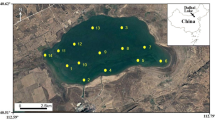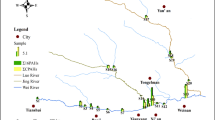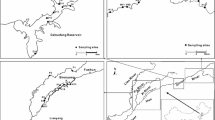Abstract
Polycyclic aromatic hydrocarbons (PAHs), as indicators of anthropogenic activities, existed in sediments may pose potential risk to environment. In the present study, we assessed occurrence, composition, and risk assessment of PAHs in Wei River Basin. It was found that the total concentration (∑16PAHs) of selected PAHs in sediments for the main stream of Wei River and its tributaries ranged from n.d. (not detectable) to 577.25 ng g−1 and 36.35 to 2348.77 ng g−1, respectively. The PAHs were mostly dominated by PHE and FLT. Based on the diagnostic ratios of FLT/(FLT + PYR), BaA/(BaA + CHR), and PCA analysis, we deducted that diesel emissions and incomplete combustion of petroleum fuels were predominant in the selected area. For sediment quality guidelines (SQGs), adverse effects of three PAHs (ACE, PHE, and BgP) in sediment were occasionally observed, while the other 9 PAHs were considered to occur rarely. The total carcinogenicity of PAHs assessed by TEQBaP ranged from n.d. to 138.84 ng g−1, and BaP played the dominant role. The ecological risk of individual PAHs (ACE, FLU, PHE, FLT, PYR, BaA, BbF, BaP) were moderate, while other compounds were negligible. Total ecological risk of ∑16PAHs posed low to moderate ecological risk in Wei River Basin.




Similar content being viewed by others
Data Availability
The datasets generated during and/or analyzed during the current study are available from the corresponding author on reasonable request.
References
Andersson, J. T., & Achten, C. (2015). Time to Say Goodbye to the 16 EPA PAHs? Toward an Up-to-Date Use of PACs for Environmental Purposes. Polycyclic Aromatic Compounds, 35(2–4), 330–354. https://doi.org/10.1080/10406638.2014.991042
Ahmad, M., Yang, Q., Zhang, Y., Ling, J., Sajjad, W., Qi, S., Zhou, W., Zhang, Y., Lin, X., Zhang, Y., & Dong, J. (2019). The distinct response of phenanthrene enriched bacterial consortia to different PAHs and their degradation potential: A mangrove sediment microcosm study. Journal of Hazardous Materials, 380, 120863. https://doi.org/10.1016/j.jhazmat.2019.120863
Bandowe, B. A. M., Bigalke, M., Boamah, L., Nyarko, E., Saalia, F. K., & Wilcke, W. (2014a). Polycyclic aromatic compounds (PAHs and oxygenated PAHs) and trace metals in fish species from Ghana (West Africa): Bioaccumulation and health risk assessment. Environment International, 65, 135–146. https://doi.org/10.1016/j.envint.2013.12.018
Bandowe, B. A. M., Meusel, H., Huang, R.-J., Ho, K., Cao, J., Hoffmann, T., & Wilcke, W. (2014b). PM2.5-bound oxygenated PAHs, nitro-PAHs and parent-PAHs from the atmosphere of a Chinese megacity: Seasonal variation, sources and cancer risk assessment. Science of the Total Environment, 473–474, 77–87. https://doi.org/10.1016/j.scitotenv.2013.11.108
Barakat, A. O., Mostafa, A., Wade, T. L., Sweet, S. T., & El Sayed, N. B. (2011). Distribution and characteristics of PAHs in sediments from the Mediterranean coastal environment of Egypt. Marine Pollution Bulletin, 62(9), 1969–1978. https://doi.org/10.1016/j.marpolbul.2011.06.024
Boonyatumanond, R., Wattayakorn, G., Togo, A., & Takada, H. (2006). Distribution and origins of polycyclic aromatic hydrocarbons (PAHs) in riverine, estuarine, and marine sediments in Thailand. Marine Pollution Bulletin, 52(8), 942–956. https://doi.org/10.1016/j.marpolbul.2005.12.015
Cao, Z., Liu, J., Luan, Y., Li, Y., Ma, M., Xu, J., & Han, S. (2010). Distribution and ecosystem risk assessment of polycyclic aromatic hydrocarbons in the Luan River, China. Ecotoxicology, 19(5), 827–837. https://doi.org/10.1007/s10646-010-0464-5
Chen, Y., Jia, R., & Yang, S. (2015). Distribution and source of polycyclic aromatic hydrocarbons (PAHs) in water dissolved phase, suspended particulate matter and sediment from Weihe river in Northwest China. International Journal of Environmental Research and Public Health, 12(11), 14148–14163. https://doi.org/10.3390/ijerph121114148
Dahle, S., Savinov, V. M., Matishov, G. G., Evenset, A., & Næs, K. (2003). Polycyclic aromatic hydrocarbons (PAHs) in bottom sediments of the Kara Sea shelf, Gulf of Ob and Yenisei Bay. Science of the Total Environment, 306(1), 57–71. https://doi.org/10.1016/S0048-9697(02)00484-9
De Luca, G., Furesi, A., Micera, G., Panzanelli, A., Piu, P. C., Pilo, M. I., Spano, N., & Sanna, G. (2005). Nature, distribution and origin of polycyclic aromatic hydrocarbons (PAHs) in the sediments of Olbia harbor (Northern Sardinia, Italy). Marine Pollution Bulletin, 50(11), 1223–1232. https://doi.org/10.1016/j.marpolbul.2005.04.021
Dhar, K., Subashchandrabose, S. R., Venkateswarlu, K., Krishnan, K., & Megharaj, M. (2020). Anaerobic microbial degradation of polycyclic aromatic hydrocarbons: a comprehensive review. In P. de Voogt (Ed.), Reviews of Environmental Contamination and Toxicology (Vol. 251, pp. 25–108). Springer International Publishing.
dos Santos, I. F., Ferreira, S. L. C., Domínguez, C., & Bayona, J. M. (2018). Analytical strategies for determining the sources and ecotoxicological risk of PAHs in river sediment. Microchemical Journal, 137, 90–97. https://doi.org/10.1016/j.microc.2017.09.025
Edokpayi, J. N., Odiyo, J. O., Popoola, O. E., & Msagati, T. A. (2016). Determination and distribution of polycyclic aromatic hydrocarbons in rivers, sediments and wastewater effluents in Vhembe District, South Africa. International Journal of Environmental Research and Public Health, 13(4), 387.
Gao, P., da Silva, E., Hou, L., Denslow, N. D., Xiang, P., & Ma, L. Q. (2018). Human exposure to polycyclic aromatic hydrocarbons: Metabolomics perspective. Environment International, 119, 466–477. https://doi.org/10.1016/j.envint.2018.07.017
Goswami, P., Ohura, T., Guruge, K. S., Yoshioka, M., Yamanaka, N., Akiba, M., & Munuswamy, N. (2016). Spatio-temporal distribution, source, and genotoxic potential of polycyclic aromatic hydrocarbons in estuarine and riverine sediments from southern India. Ecotoxicology and Environmental Safety, 130, 113–123. https://doi.org/10.1016/j.ecoenv.2016.04.016
Han, Y. M., Bandowe, B. A. M., Wei, C., Cao, J. J., Wilcke, W., Wang, G. H., Ni, H. Y., Jin, Z. D., An, Z. S., & Yan, B. Z. (2015). Stronger association of polycyclic aromatic hydrocarbons with soot than with char in soils and sediments. Chemosphere, 119, 1335–1345. https://doi.org/10.1016/j.chemosphere.2014.02.021
He, X., Pang, Y., Song, X., Chen, B., Feng, Z., & Ma, Y. (2014). Distribution, sources and ecological risk assessment of PAHs in surface sediments from Guan River Estuary, China. Marine Pollution Bulletin, 80(1), 52–58. https://doi.org/10.1016/j.marpolbul.2014.01.051
Headley, J. V., Akre, C., Conly, F. M., Peru, K. M., & Dickson, L. C. (2001). Preliminary characterization and source assessment of PAHs in tributary sediments of the Athabasca River, Canada. Environmental Forensics, 2(4), 335–345. https://doi.org/10.1006/enfo.2001.0064
Horii, Y., Ohura, T., Yamashita, N., & Kannan, K. (2009). Chlorinated polycyclic aromatic hydrocarbons in sediments from industrial areas in Japan and the United States. Archives of Environmental Contamination and Toxicology, 57(4), 651. https://doi.org/10.1007/s00244-009-9372-1
Keshavarzi, B., Abbasi, S., Moore, F., Mehravar, S., Sorooshian, A., Soltani, N., & Najmeddin, A. (2018). Contamination level, source identification and risk assessment of potentially toxic elements (PTEs) and polycyclic aromatic hydrocarbons (PAHs) in street dust of an important commercial center in Iran. Environmental Management, 62(4), 803–818. https://doi.org/10.1007/s00267-018-1079-5
Keshavarzifard, M., Zakaria, M. P., Shau Hwai, T., Yusuff, F. F. M., Mustafa, S., Vaezzadeh, V., Magam, S. M., Masood, N., Alkhadher, S. A. A., & Abootalebi-Jahromi, F. (2014). Baseline distributions and sources of polycyclic aromatic hydrocarbons (PAHs) in the surface sediments from the Prai and Malacca Rivers, Peninsular Malaysia. Marine Pollution Bulletin, 88(1), 366–372. https://doi.org/10.1016/j.marpolbul.2014.08.014
Kong, S., Ji, Y., Li, Z., Lu, B., & Bai, Z. (2013). Emission and profile characteristic of polycyclic aromatic hydrocarbons in PM2.5 and PM10 from stationary sources based on dilution sampling. Atmospheric Environment, 77, 155–165. https://doi.org/10.1016/j.atmosenv.2013.04.073
Larsen, R. K., & Baker, J. E. (2003). Source apportionment of polycyclic aromatic hydrocarbons in the urban atmosphere: A comparison of three methods. Environmental Science & Technology, 37(9), 1873–1881. https://doi.org/10.1021/es0206184
Lee, B.-K., & Dong, T. T. T. (2010). Effects of road characteristics on distribution and toxicity of polycyclic aromatic hydrocarbons in urban road dust of Ulsan, Korea. Journal of Hazardous Materials, 175(1), 540–550. https://doi.org/10.1016/j.jhazmat.2009.10.039
Li, C., Huo, S., Yu, Z., Xi, B., Zeng, X., & Wu, F. (2014). Spatial distribution, potential risk assessment, and source apportionment of polycyclic aromatic hydrocarbons (PAHs) in sediments of Lake Chaohu, China. Environmental Science and Pollution Research, 21(20), 12028–12039. https://doi.org/10.1007/s11356-014-3137-8
Li, W.-H., Tian, Y.-Z., Shi, G.-L., Guo, C.-S., Li, X., & Feng, Y.-C. (2012). Concentrations and sources of PAHs in surface sediments of the Fenhe reservoir and watershed, China. Ecotoxicology and Environmental Safety, 75, 198–206. https://doi.org/10.1016/j.ecoenv.2011.08.021
Liang, L., Song, X., Kong, J., Shen, C., Huang, T., & Hu, Z. (2014). Anaerobic biodegradation of high-molecular-weight polycyclic aromatic hydrocarbons by a facultative anaerobe Pseudomonas sp. JP1. Biodegradation, 25(6), 825–833. https://doi.org/10.1007/s10532-014-9702-5
Liu, G., Niu, J., Guo, W., An, X., & Zhao, L. (2016). Ecological and health risk-based characterization of agricultural soils contaminated with polycyclic aromatic hydrocarbons in the vicinity of a chemical plant in China. Chemosphere, 163, 461–470. https://doi.org/10.1016/j.chemosphere.2016.08.056
Liu, L.-Y., Wang, J.-Z., Wei, G.-L., Guan, Y.-F., & Zeng, E. Y. (2012). Polycyclic aromatic hydrocarbons (PAHs) in continental shelf sediment of China: Implications for anthropogenic influences on coastal marine environment. Environmental Pollution, 167, 155–162. https://doi.org/10.1016/j.envpol.2012.03.038.
Long, E. R., Macdonald, D. D., Smith, S. L., & Calder, F. D. (1995). Incidence of adverse biological effects within ranges of chemical concentrations in marine and estuarine sediments. Environmental Management, 19(1), 81–97. https://doi.org/10.1007/BF02472006
Lu, X., Zhang, X., & Wang, F. (2008). Natural radioactivity in sediment of Wei River, China. Environmental Geology, 53(7), 1475–1481. https://doi.org/10.1007/s00254-007-0756-0
Qi, Mai, Yang, E. Y., Zhang, Fu, G., Sheng, Peng, & Wang. (2003). Distribution of polycyclic aromatic hydrocarbons in the Coastal Region off Macao, China: Assessment of input sources and transport pathways using compositional analysis. Environmental Science & Technology, 37(21), 4855–4863. https://doi.org/10.1021/es034514k
Malik, A., Verma, P., Singh, A. K., & Singh, K. P. (2011). Distribution of polycyclic aromatic hydrocarbons in water and bed sediments of the Gomti River, India. Environmental Monitoring and Assessment, 172(1), 529–545. https://doi.org/10.1007/s10661-010-1352-4
Mostafa, A. R., Hegazi, A. H., El-Gayar, M. S., & Andersson, J. T. (2009). Source characterization and the environmental impact of urban street dusts from Egypt based on hydrocarbon distributions. Fuel, 88(1), 95–104. https://doi.org/10.1016/j.fuel.2008.08.006
Mu, Q., Shiraiwa, M., Octaviani, M., Ma, N., Ding, A., Su, H., Lammel, G., Pöschl, U., & Cheng, Y. (2018). Temperature effect on phase state and reactivity controls atmospheric multiphase chemistry and transport of PAHs. Science Advances, 4(3), eaap7314. https://doi.org/10.1126/sciadv.aap7314
Nilsen, E. B., Rosenbauer, R. J., Fuller, C. C., & Jaffe, B. J. (2015). Sedimentary organic biomarkers suggest detrimental effects of PAHs on estuarine microbial biomass during the 20th century in San Francisco Bay, CA, USA. Chemosphere, 119, 961–970. https://doi.org/10.1016/j.chemosphere.2014.08.053
National Bureau of Statistics of China (2019). China New Statistical Yearbooks. Retrieved from http://www.stats.gov.cn/tjsj/ndsj/2019/indexeh.htm. Accessed date September 13th, 2021.
Okuda, T., Okamoto, K., Tanaka, S., Shen, Z., Han, Y., & Huo, Z. (2010). Measurement and source identification of polycyclic aromatic hydrocarbons (PAHs) in the aerosol in Xi’an, China, by using automated column chromatography and applying positive matrix factorization (PMF). Science of the Total Environment, 408(8), 1909–1914. https://doi.org/10.1016/j.scitotenv.2010.01.040
Pozo, K., Perra, G., Menchi, V., Urrutia, R., Parra, O., Rudolph, A., & Focardi, S. (2011). Levels and spatial distribution of polycyclic aromatic hydrocarbons (PAHs) in sediments from Lenga Estuary, central Chile. Marine Pollution Bulletin, 62(7), 1572–1576. https://doi.org/10.1016/j.marpolbul.2011.04.037
Qin, N., He, W., Kong, X.-Z., Liu, W.-X., He, Q.-S., Yang, B., Wang, Q.-M., Yang, C., Jiang, Y.-J., Jorgensen, S. E., Xu, F.-L., & Zhao, X.-L. (2014). Distribution, partitioning and sources of polycyclic aromatic hydrocarbons in the water–SPM–sediment system of Lake Chaohu, China. Science of the Total Environment, 496, 414–423. https://doi.org/10.1016/j.scitotenv.2014.07.045
Ranjbar Jafarabadi, A., Dashtbozorg, M., Mitra, S., Riyahi Bakhtiari, A., Mohamadjafari Dehkordi, S., & Cappello, T. (2019). Historical sedimentary deposition and ecotoxicological impact of aromatic biomarkers in sediment cores from ten coral reefs of the Persian Gulf, Iran. Science of the Total Environment, 696, 133969. https://doi.org/10.1016/j.scitotenv.2019.133969
Shi, Z., Tao, S., Pan, B., Fan, W., He, X. C., Zuo, Q., Wu, S. P., Li, B. G., Cao, J., Liu, W. X., Xu, F. L., Wang, X. J., Shen, W. R., & Wong, P. K. (2005). Contamination of rivers in Tianjin, China by polycyclic aromatic hydrocarbons. Environmental Pollution, 134(1), 97–111. https://doi.org/10.1016/j.envpol.2004.07.014
Sofowote, U. M., McCarry, B. E., & Marvin, C. H. (2008). Source Apportionment of PAH in Hamilton Harbour Suspended Sediments: Comparison of Two Factor Analysis Methods. Environmental Science & Technology, 42(16), 6007–6014. https://doi.org/10.1021/es800219z
Sun, J.-L., Ni, H.-G., & Zeng, H. (2012). Ecological risk assessment of parent and halogenated polycyclic aromatic hydrocarbons in surface sediments from an urban river in south China. Environmental Toxicology and Chemistry, 31(8), 1867–1873. https://doi.org/10.1002/etc.1890.
Sun, Y., Wu, S., & Gong, G. (2019). Trends of research on polycyclic aromatic hydrocarbons in food: A 20-year perspective from 1997 to 2017. Trends in Food Science & Technology, 83, 86–98. https://doi.org/10.1016/j.tifs.2018.11.015
Tu, Y. T., Ou, J. H., Tsang, D. C. W., Dong, C. D., Chen, C. W., & Kao, C. M. (2018). Source identification and ecological impact evaluation of PAHs in urban river sediments: A case study in Taiwan. Chemosphere, 194, 666–674. https://doi.org/10.1016/j.chemosphere.2017.12.008
Tuncel, S. G., & Topal, T. (2015). Polycyclic aromatic hydrocarbons (PAHs) in sea sediments of the Turkish Mediterranean coast, composition and sources. Environmental Science and Pollution Research, 22(6), 4213–4221. https://doi.org/10.1007/s11356-014-3621-1
Vane, C. H., Harrison, I., & Kim, A. W. (2007). Assessment of polyaromatic hydrocarbons (PAHs) and polychlorinated biphenyls (PCBs) in surface sediments of the Inner Clyde Estuary, Uk. Marine Pollution Bulletin, 54(8), 1301–1306. https://doi.org/10.1016/j.marpolbul.2007.04.005
Wang, C., Zou, X., Gao, J., Zhao, Y., Yu, W., Li, Y., & Song, Q. (2016). Pollution status of polycyclic aromatic hydrocarbons in surface sediments from the Yangtze River Estuary and its adjacent coastal zone. Chemosphere, 162, 80–90. https://doi.org/10.1016/j.chemosphere.2016.07.075
Wang, H.-S., Cheng, Z., Liang, P., Shao, D.-D., Kang, Y., Wu, S.-C., Wong, C. K. C., & Wong, M. H. (2010). Characterization of PAHs in surface sediments of aquaculture farms around the Pearl River Delta. Ecotoxicology and Environmental Safety, 73(5), 900–906. https://doi.org/10.1016/j.ecoenv.2010.04.010
Wang, J., Zhang, X., Ling, W., Liu, R., Liu, J., Kang, F., & Gao, Y. (2017). Contamination and health risk assessment of PAHs in soils and crops in industrial areas of the Yangtze River Delta region, China. Chemosphere, 168, 976–987. https://doi.org/10.1016/j.chemosphere.2016.10.113
Wei, C., Bandowe, B. A. M., Han, Y., Cao, J., Zhan, C., & Wilcke, W. (2015). Polycyclic aromatic hydrocarbons (PAHs) and their derivatives (alkyl-PAHs, oxygenated-PAHs, nitrated-PAHs and azaarenes) in urban road dusts from Xi’an, Central China. Chemosphere, 134, 512–520. https://doi.org/10.1016/j.chemosphere.2014.11.052
Wu, Q., Leung, J. Y. S., Tam, N. F. Y., Chen, S., Mai, B., Zhou, X., Xia, L., & Geng, X. (2014). Biological risk and pollution history of polycyclic aromatic hydrocarbons (PAHs) in Nansha mangrove, South China. Marine Pollution Bulletin, 85(1), 92–98. https://doi.org/10.1016/j.marpolbul.2014.06.014
Wu, W., Xu, Z., Zhan, C., Yin, X., & Yu, S. (2015). A new framework to evaluate ecosystem health: A case study in the Wei River basin, China. Environmental Monitoring and Assessment, 187(7), 460. https://doi.org/10.1007/s10661-015-4596-1
Xu, J., Guo, J.-Y., Liu, G.-R., Shi, G.-L., Guo, C.-S., Zhang, Y., & Feng, Y.-C. (2014). Historical trends of concentrations, source contributions and toxicities for PAHs in dated sediment cores from five lakes in western China. Science of the Total Environment, 470–471, 519–526. https://doi.org/10.1016/j.scitotenv.2013.10.022
Yang, B., Zhou, L., Xue, N., Li, F., Li, Y., Vogt, R. D., Cong, X., Yan, Y., & Liu, B. (2013). Source apportionment of polycyclic aromatic hydrocarbons in soils of Huanghuai Plain, China: Comparison of three receptor models. Science of the Total Environment, 443, 31–39. https://doi.org/10.1016/j.scitotenv.2012.10.094
Yang, W., Lang, Y., & Li, G. (2014). Cancer risk of polycyclic aromatic hydrocarbons (PAHs) in the soils from Jiaozhou Bay wetland. Chemosphere, 112, 289–295. https://doi.org/10.1016/j.chemosphere.2014.04.074
Yang, X., Duan, J., Wang, L., Li, W., Guan, J., Beecham, S., & Mulcahy, D. (2015). Heavy metal pollution and health risk assessment in the Wei River in China. Environmental Monitoring and Assessment, 187(3), 111. https://doi.org/10.1007/s10661-014-4202-y
Yao, Y., Wang, D., Ma, H., Li, C., Chang, X., Low, P., Hammond, S. K., Turyk, M. E., Wang, J., & Liu, S. (2019). The impact on T-regulatory cell related immune responses in rural women exposed to polycyclic aromatic hydrocarbons (PAHs) in household air pollution in Gansu, China: A pilot investigation. Environmental Research, 173, 306–317. https://doi.org/10.1016/j.envres.2019.03.053
Yu, S., Xu, Z., Wu, W., & Zuo, D. (2016). Effect of land use types on stream water quality under seasonal variation and topographic characteristics in the Wei River basin, China. Ecological Indicators, 60, 202–212. https://doi.org/10.1016/j.ecolind.2015.06.029
Yunker, M. B., Macdonald, R. W., Vingarzan, R., Mitchell, R. H., Goyette, D., & Sylvestre, S. (2002). PAHs in the Fraser River basin: A critical appraisal of PAH ratios as indicators of PAH source and composition. Organic Geochemistry, 33(4), 489–515. https://doi.org/10.1016/S0146-6380(02)00002-5
Zhang, D., Liu, J., Jiang, X., Cao, K., Yin, P., & Zhang, X. (2016). Distribution, sources and ecological risk assessment of PAHs in surface sediments from the Luan River Estuary, China. Marine Pollution Bulletin, 102(1), 223–229. https://doi.org/10.1016/j.marpolbul.2015.10.043
Zhang, J., Wang, J., Hua, P., & Krebs, P. (2015). The qualitative and quantitative source apportionments of polycyclic aromatic hydrocarbons in size dependent road deposited sediment. Science of the Total Environment, 505, 90–101. https://doi.org/10.1016/j.scitotenv.2014.09.091
Zhang, R., Zhang, F., & Zhang, T.-C. (2013). Sedimentary records of PAHs in a sediment core from tidal flat of Haizhou Bay, China. Science of the Total Environment, 450–451, 280–288. https://doi.org/10.1016/j.scitotenv.2013.02.029
Funding
This project is supported by the Program Foundation of Institute for Scientific Research of Karst Area of NSFC-GZGOV (U1612442), Scientific research project of Guangzhou University (YK2020017), Guangzhou University’s 2017 training program for young top-notch personnel (BJ201713), Shaanxi Water Conservancy Science and Technology Plan Project (2013slkj-11), and Research Grants Council of the Hong Kong Special Administration Region, China (UGC/FDS16/M07/19).
Author information
Authors and Affiliations
Corresponding author
Ethics declarations
Conflict of Interest
The authors declare no competing interests.
Additional information
Publisher's Note
Springer Nature remains neutral with regard to jurisdictional claims in published maps and institutional affiliations.
Supplementary Information
Below is the link to the electronic supplementary material.
Rights and permissions
About this article
Cite this article
Shi, Y., Lu, Y., Zhang, Y. et al. Investigation into Polycyclic Aromatic Hydrocarbons in Sediments of Wei River Basin. Water Air Soil Pollut 232, 476 (2021). https://doi.org/10.1007/s11270-021-05403-w
Received:
Accepted:
Published:
DOI: https://doi.org/10.1007/s11270-021-05403-w




